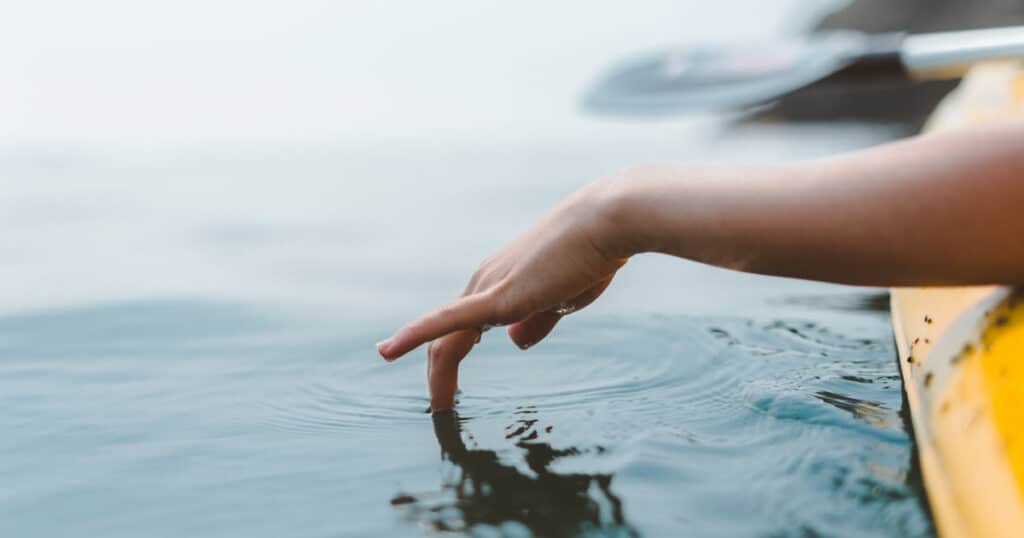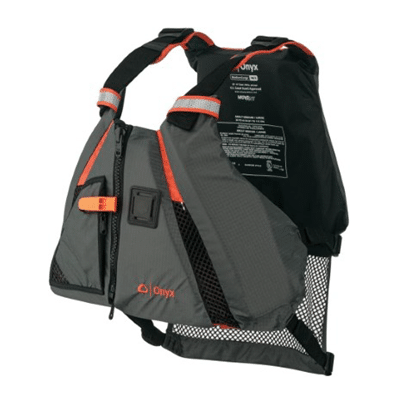Follow the call of adventure! It’s time to explore the great outdoors. Since you’ve found your way here, I’m guessing you’ve decided kayaking is the water sport for you. But you’ve got to start somewhere, and that’s at the beginning. Let’s explore everything you need to know about kayaking for beginners.
Too many novices assume they can just learn on the fly, but classes are essential. Find a certified kayaking instructor offering classes for beginners. As well as taking a course, there are plenty of things to learn. Let’s start your kayaking journey here.
Let’s learn about:
- Types of kayaks
- Kayaking gear
- Clothes to wear for kayaking
- How to hold your paddle
- Basic kayaking strokes
- How to launch your kayak
- Why you should take a kayaking course
Types of Kayaks
Did you know there are several different types of kayaks? You’ll have to learn about them to decide which one is best for you.
Basic Kayak Designs
The two basic kayak designs are the sit-on-top kayak and the sit-inside kayak. I have written an article comparing these two types of kayaks. You can check it out here.
Sit-On-Top Kayak
Sit-on-top kayaks are easier to enter and exit, they tend to be wider, and they’re often more stable.
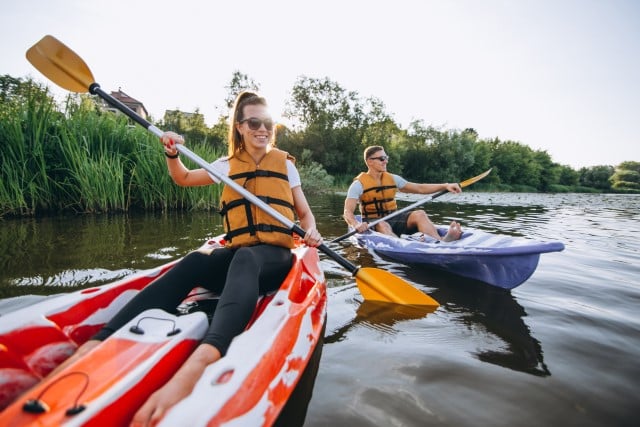
This makes them a particularly good option for kayaking beginners.
Sit-Inside Kayak
A sit-inside kayak is exactly what it sounds like: you sit inside it! This kind of kayak has a cockpit.
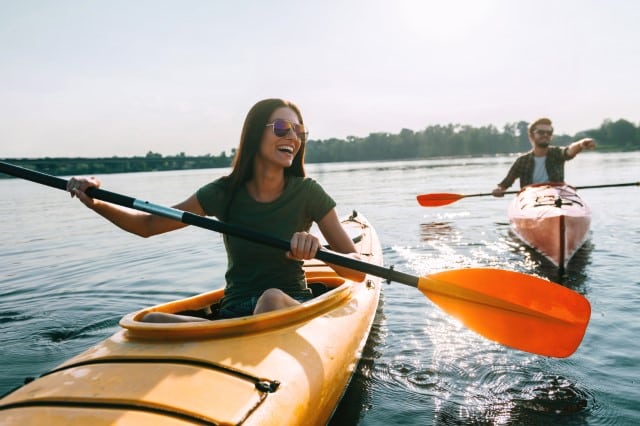
That’s an opening you climb into.
Kayak Categories by Purpose
Kayaks are also categorized by their purpose. For example, there are touring kayaks, recreational kayaks, and whitewater kayaks.
Recreational Kayak
The recreational kayak is what you want as a beginner. It features a relatively spacious cockpit (seating area).
This kayak is your one-stop-shop option, perfect for easy days on a calm lake.
Touring Kayak
These are long kayaks with relatively small cockpits.
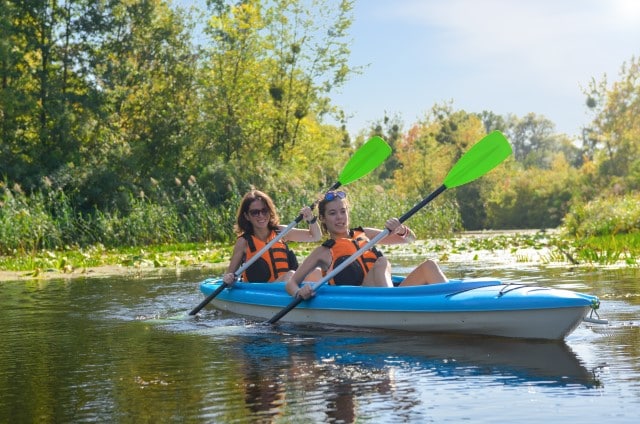
Because they are narrow and long, touring kayaks are ideal for longer journeys, hence the name.
Whitewater Kayak
As a beginner, it will definitely be a long time before you go plunging through any whitewater rapids. But if that day ever comes, you’ll need a whitewater kayak.
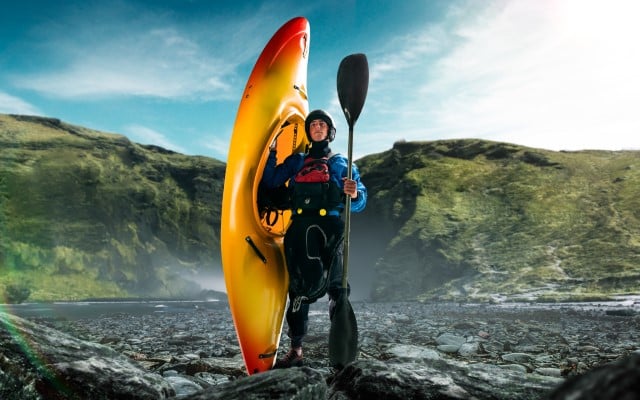
This type of kayak comes in four guises: the river runner, the creek boat, the playboat, and the longboat.
You Need the Right Gear
There is stuff everybody should have and know about if they want to be a kayaker. Here are some of the most important items here.
Paddle
Not just any paddle will do. You need a paddle designed for kayaking, and it must be an appropriate length.
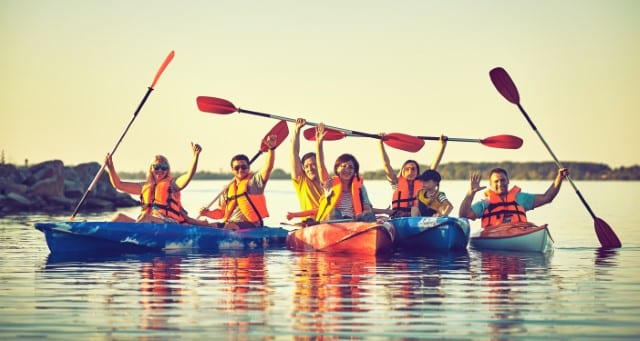
Your paddle length must work with the width of your kayak. Your height is another factor.
Don’t underestimate how important it is to have the right paddle. Certain things can go wrong if you don’t.
So, what can go wrong if you have the wrong paddle size? Well, the main thing is not being able to move your kayak straight through the water.
A paddle that is too long for your kayak and/or you will mean you can’t keep up the right level of traction in the water. This means you won’t be able to move through the water efficiently.
A paddle that is too short will cause problems like injuries to your fingers and knuckles. Its limited length will mean it stays too close to the watercraft.
The importance of getting the right paddle size cannot be overstated.
Ask the experts at your local watersports equipment store for advice. Bring information on your kayak size.
Personal Floatation Device (PFD)
While every kayaker should wear a personal floatation device (PFD), it’s especially essential for beginners. It doesn’t matter how good a swimmer you are.
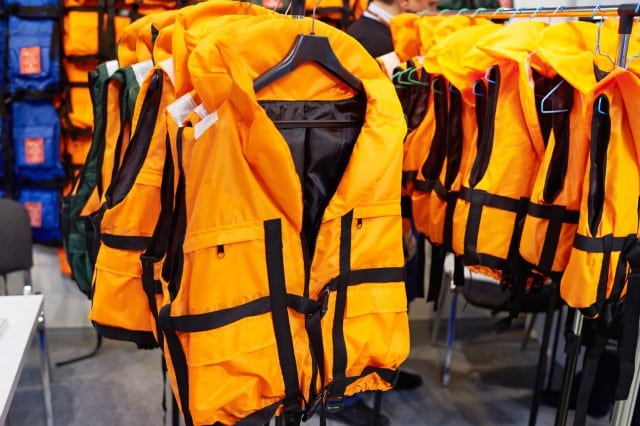
There are accidents and emergencies that can happen that may make a PFD the difference between life and death, and for many people wearing a life jacket is the law.
If you find a life jacket too constricting, you can wear a buoyancy aid instead. If you do wear a life jacket, make sure to get it professionally fitted.
An improperly fitting life jacket can be dangerous.
Bilge Pump
You should always have a bilge pump on hand in your kayak. If water gets into your kayak and cockpit, you need to get it out somehow. And that’s what a bilge pump is for.
I own and recommend this Bilge Pump from Perception. It has lasted me years, it’s lightweight and reliable.
Dry Bags
It’s pretty easy to guess the purpose of dry bags. They keep things dry! A good example is your cell phone.
You don’t want water splashing on that, causing damage. But there are other items you should put in dry bags, too.
You should also store items like your watch, sunscreen, and snacks.
You’ll find many different dry bags on the market that you can choose from.
Generally speaking, you should look for a dry bag made of a high-denier material. This gives it durability.
For obvious reasons, your dry bags must be water-resistant or waterproof. Materials often used include PVC and polyurethane.
Manufacturers sometimes combine materials to achieve better protection.
There are lots of options for waterproof dry bags, but my favorite is this one from Amazon.
Wear Appropriate Clothes
It’s usually not enough to just wear your usual summer clothes for kayaking. After all, you might fall in the water.
Some kayakers wear wetsuits because of this. That’s especially true for kayakers who travel further out on the water.
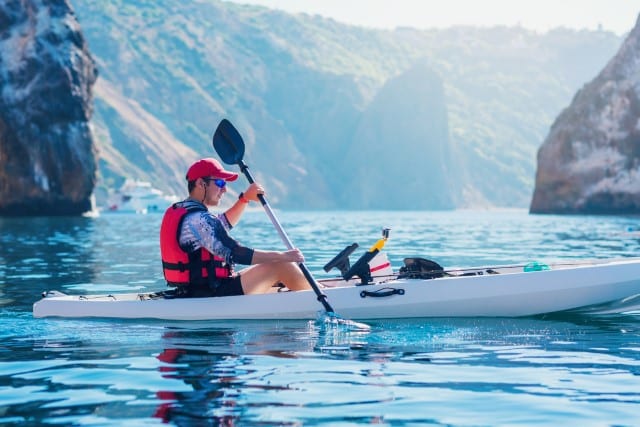
Think about the potential temperature of the water rather than just the temperature of the air outside. Water temperature can be a lot colder than air temperature, and this can be dangerous.
Most experienced kayakers recommend dressing in layers. Most importantly, keep your PFD (personal floatation device) on at all times when you’re on the water.
Wear durable clothing that is made for wet conditions. One material you should stay away from is cotton.
That is because cotton tends to retain water for long periods, and that’s the opposite of what you want!
Seek clothing that is made from quick-drying, moisture-wicking fabrics. These fabrics are often made of specially designed types of polyester and nylon.
Of course, you also need freedom of movement so you can paddle. Look for clothes made of abrasion-resistant fabrics.
Check Your Zippers
This is something many beginner kayakers don’t realize. You should stay away from zippers (and any other kind of clothing hardware such as fasteners) that are made from materials that can rust.
Metals quickly corrode from exposure to saltwater, and even sometimes freshwater.
You’re better off with sturdy plastic zippers and fasteners.
There’s a Right Way to Hold Your Paddle
So, you are in your kayak and floating. Fantastic! But you’ll float aimlessly without knowing how to paddle a kayak! You could end up going in circles, having no control over your destination.
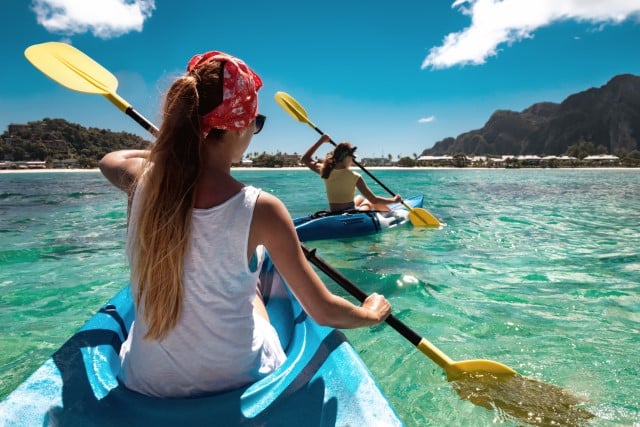
It doesn’t have to be like this! Just follow these simple paddling instructions.
- Hold the paddle with two hands and center the paddle pole atop your head.
- Lower the paddle
- Make sure the paddle blades are in line with each other
- Check each blade to ensure the longer edge of each is facing up
- The scooped side of the blades should face you, which is not easy to see so may take some practice
- Don’t grip the paddle too tight. Instead, make an “O”, using your thumb and index finger to close around the pole. Close the rest of your fingers around the paddle.
Learn Kayaking Beginner’s Strokes
The strokes you make with the paddle propel you through the water. While there are numerous strokes in the kayaking world, these are the basics:
Forward Stroke
Your go-to, the forward stroke is perhaps the best-known and most-used paddle stroke.
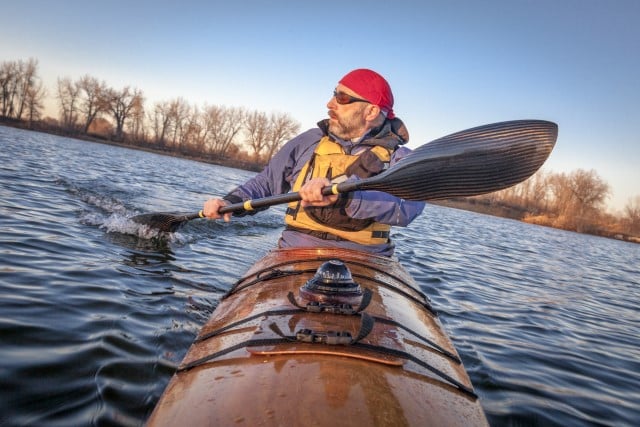
You should practice this stroke the most as a beginner. beginner.
Sweep Stroke
The forward stroke is excellent for going in straight lines, but not so much for turning. To turn your kayak, you’ll generally use a sweep stroke.
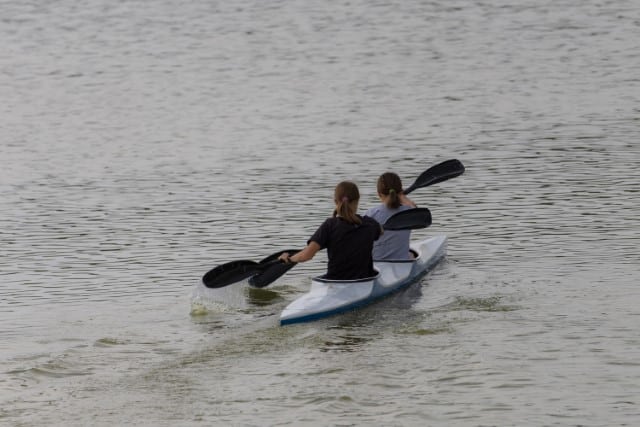
Basically, this is the technique for the forward stroke (with a wider arc) but performed only on one side of the boat.
Reverse Stroke
You’ll sometimes hear kayakers call the reverse stroke the classic brake stroke. You use this stroke to bring your kayak to a stop.
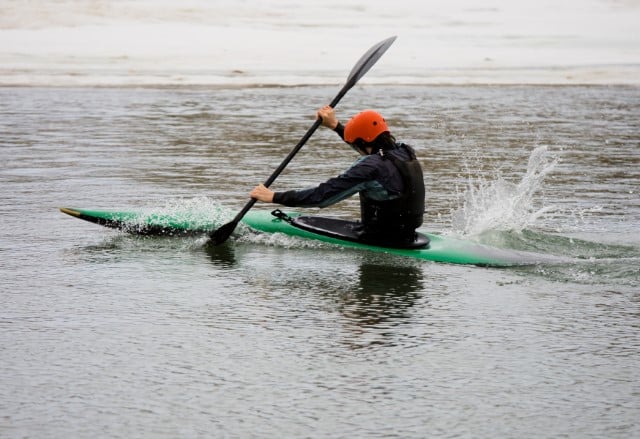
You’ll go backward if you use this stroke from a stopped position. To find out more about kayak strokes and how to do them, check out our full guide.
Launching Your Boat Can be Tricky
Launching your kayak can be a lot more challenging than actually paddling and propelling it through the water.
Yes, you can enter a kayak on flat water, but you probably won’t want to. It’s a messy, wobbly affair at the best of times and if you’re a beginner, you should avoid it.
Instead, you should launch your kayak from a slightly sloping shoreline.
Before you set out, you should consider adding an outrigger to your kayak. This device makes your watercraft more stable.
What is an Outrigger?
Outriggers look a bit like wings on your kayak. When you add an outrigger, there are arms coming out from the sides, with attachments at their ends.
If stability is your most common concern when kayaking, you should consider getting an outrigger.
Be aware, though, that your kayak will move more slowly with an outrigger than it would otherwise. Most beginners don’t consider this a problem.
Launching Your Kayak, Step-by-Step
Once you’re ready to launch your kayak, here are the steps.
1. Set your kayak perpendicular to the shoreline.
This means that your kayak and the water meet at a right angle (stern to land, bow floating in water).
2. Straddle the kayak above the cockpit.
Hold the cockpit on both sides and confidently lower your butt into the seat. Slide your feet into the kayak by lifting your legs.
3. Move back securely onto the seat.
Also, place your feet onto the footpegs inside the boat.
4. Bring your kayak into the open water.
Take the paddle and move the kayak forward.
You Should Take a Kayaking for Beginners Course
Look, I know you’re impatient and just want to get out on the water. And yes, it’s can seem quite easy to get started with kayaking.
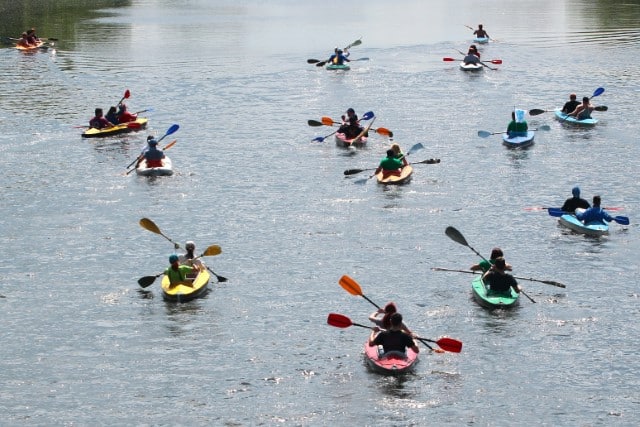
But it can be dangerous if you don’t know what you’re doing! If you’re unlucky, you could end up stranded in the middle of a lake.
So what should you do? Take lessons, preferably a whole course, with a certified instructor.
Go on group excursions and experience other kinds of instructional environments, too. This is an essential part of kayaking for beginners.
Final Thoughts: Kayaking for Beginners
And there it is, your first introduction to the world of kayaking. You’ve learned about different kayak designs and the gear you’ll need to go out on the water. You know what to wear, too!
You also now have the fundamentals of how to hold your paddle and basic kayaking strokes, as well as how to launch your kayak. You’re probably feeling pretty confident.
That’s great! But remember, you still need a kayaking course for beginners. Find a certified instructor in your area and get ready for an adventure!
And learn more about kayaks and kayaking with our impressive selection of articles on kayaks and kayaking.
Happy paddling!

